Abstract
Inhaled adenosine 5'-monophosphate (AMP) causes bronchoconstriction in atopic asthma, probably after in vivo conversion to adenosine. It has been suggested that adenosine potentiates preformed mediator release from mast cells on the mucosal surface of the airways by interacting with specific purinoceptors, without affecting the release of newly generated mediators. The airway response of nine non-atopic subjects with "intrinsic" asthma to inhaled AMP and the influence of the oral, selective H1 histamine receptor antagonist terfenadine on this response was investigated. The geometric mean provocation concentrations of histamine and AMP required to produce a 20% fall in FEV1 (PC20) were 1.82 and 13 mmol/l. In subsequent placebo controlled time course studies the FEV1 response to a single inhalation of the PC20 histamine was ablated after pretreatment with oral terfenadine 180 mg. This dose of terfenadine caused an 80% inhibition of the bronchoconstrictor response to the PC20 AMP when measured as the area under the time course-response curve and compared with the response to PC20 AMP preceded by placebo. Terfenadine 600 mg failed to increase protection against AMP further, but both doses of terfenadine delayed the time at which the mean maximum fall in FEV1 after AMP was achieved. Terfenadine 180 mg had no effect on methacholine induced bronchoconstriction in the same subjects. These data suggest that inhaled AMP may potentiate the release of preformed mediators from preactivated mast cells in the bronchial mucosa of patients with intrinsic asthma.
Full text
PDF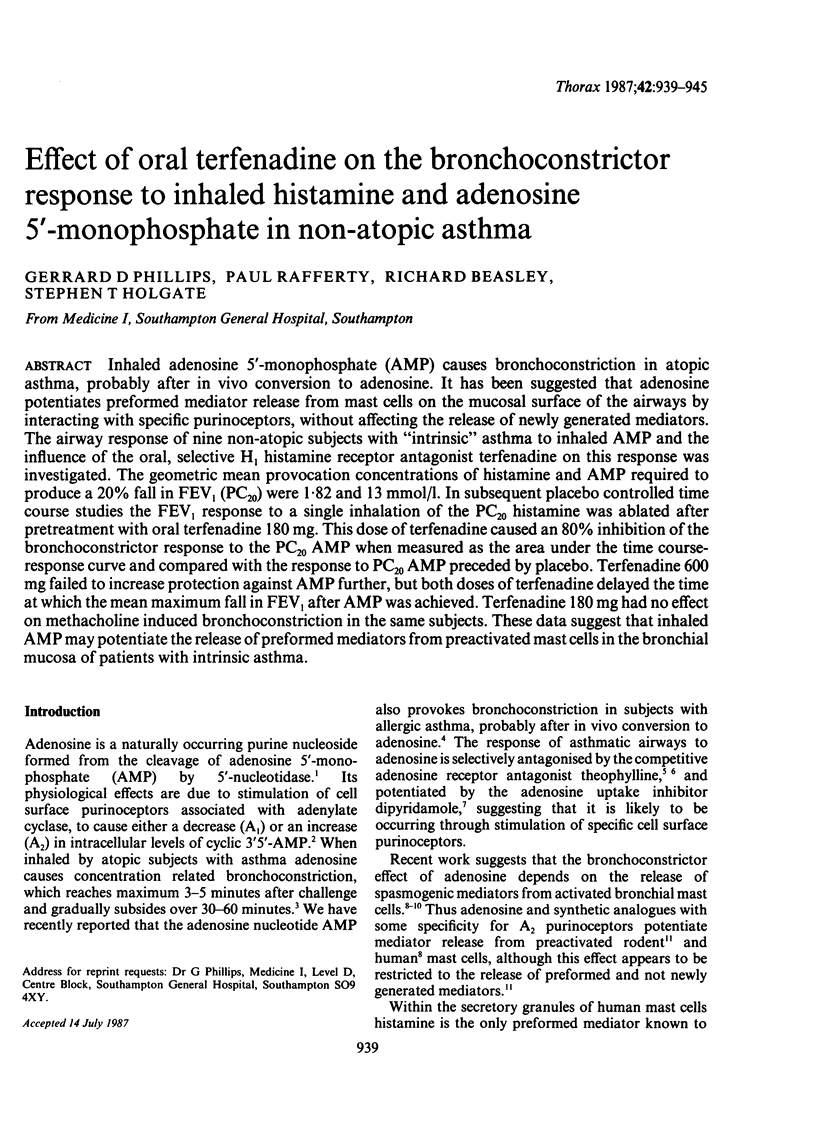
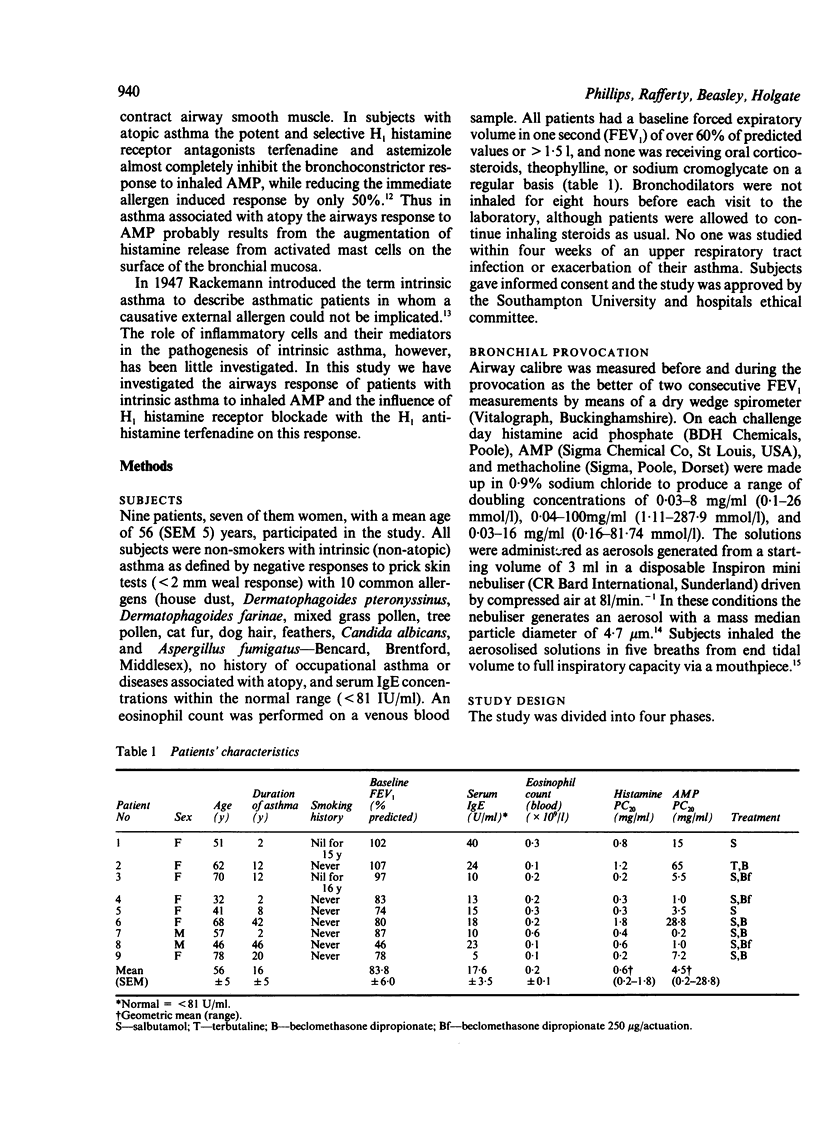
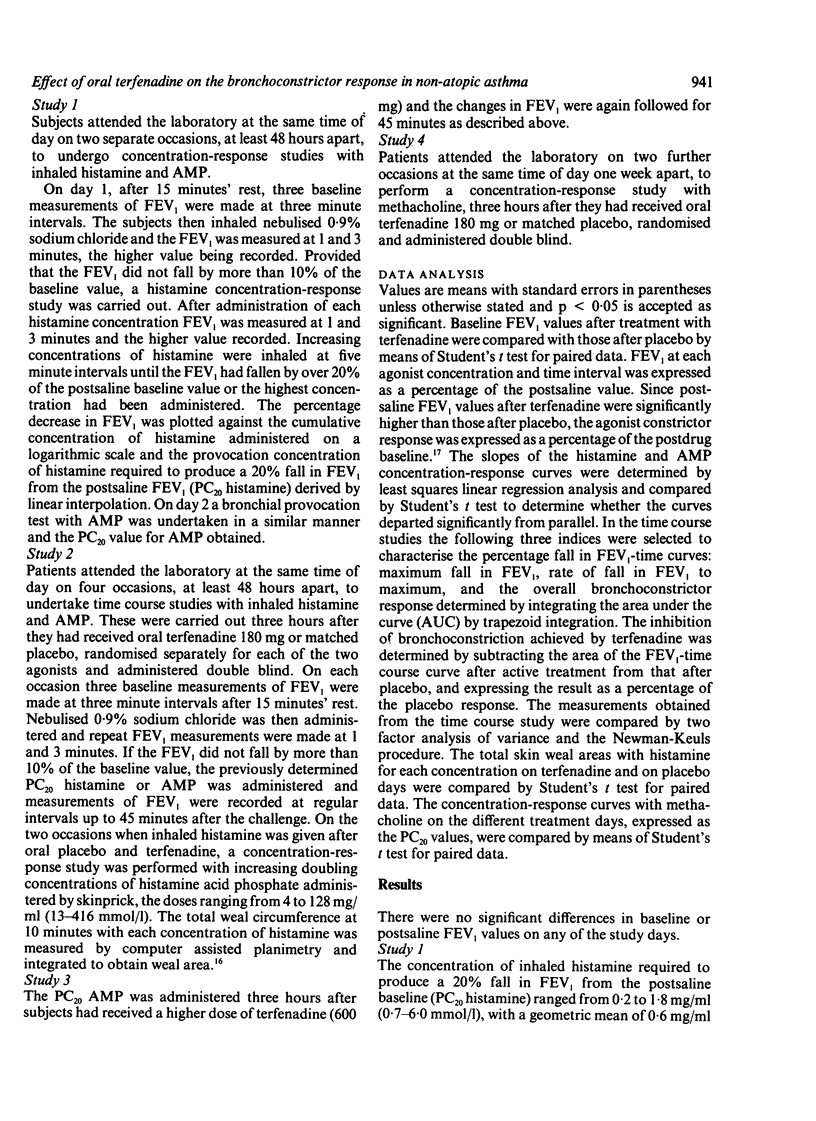
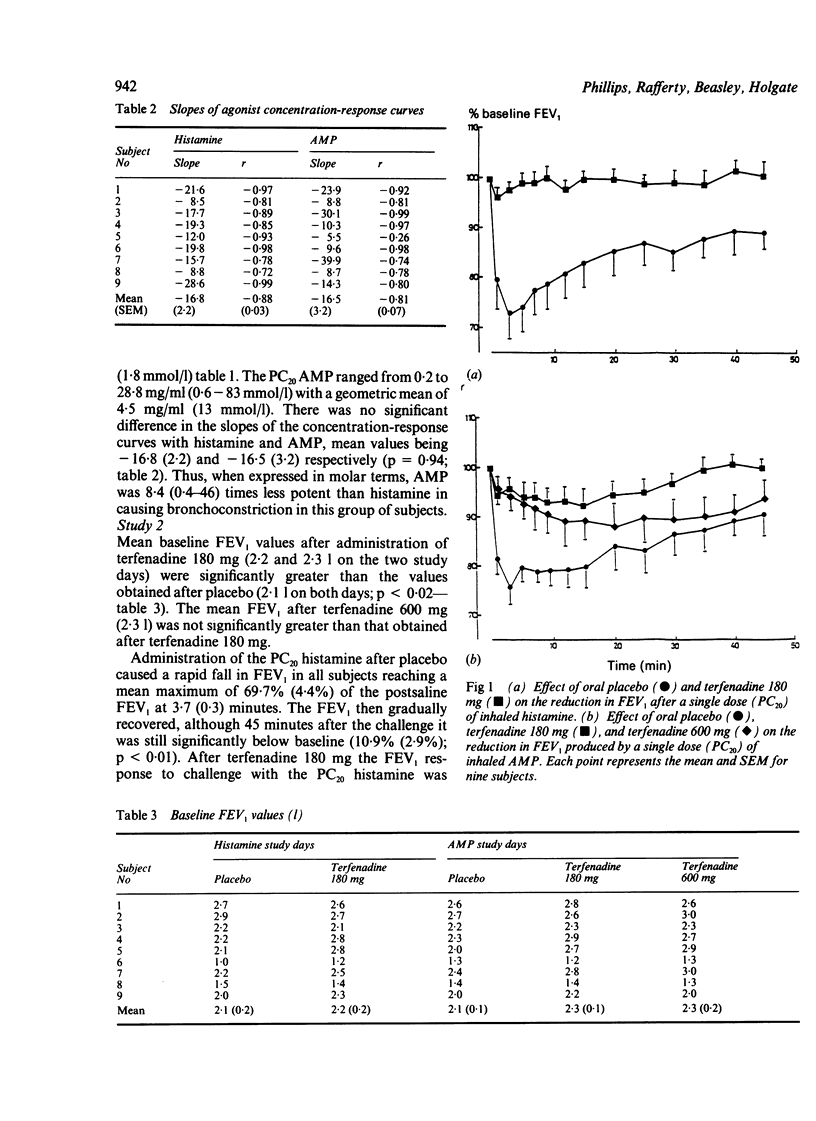

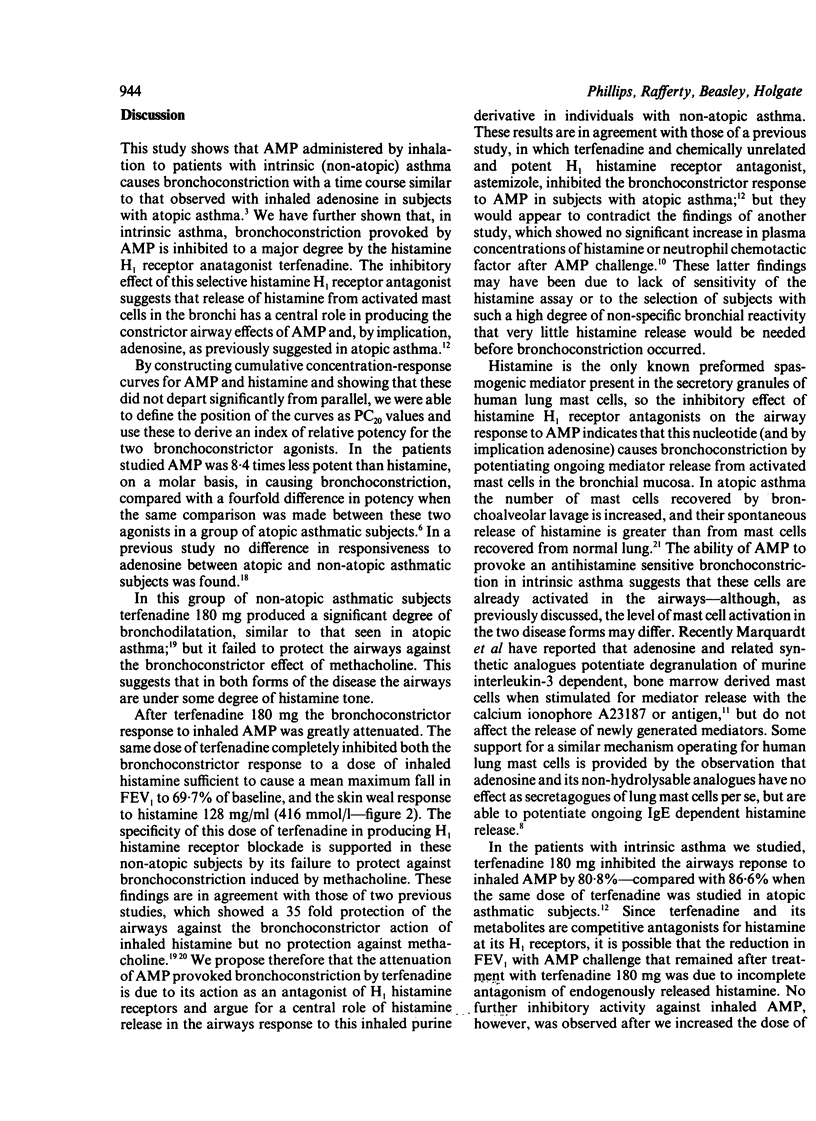
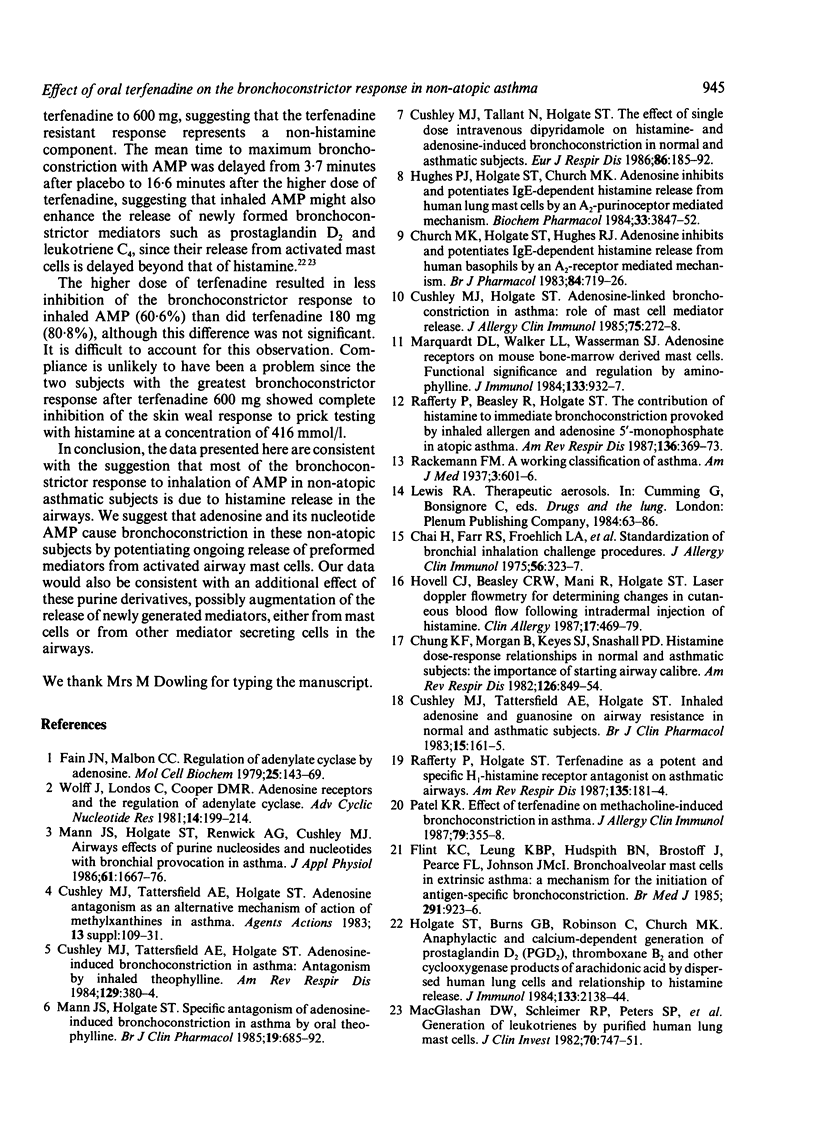
Selected References
These references are in PubMed. This may not be the complete list of references from this article.
- Chai H., Farr R. S., Froehlich L. A., Mathison D. A., McLean J. A., Rosenthal R. R., Sheffer A. L., Spector S. L., Townley R. G. Standardization of bronchial inhalation challenge procedures. J Allergy Clin Immunol. 1975 Oct;56(4):323–327. doi: 10.1016/0091-6749(75)90107-4. [DOI] [PubMed] [Google Scholar]
- Chung K. F., Morgan B., Keyes S. J., Snashall P. D. Histamine dose-response relationships in normal and asthmatic subjects. The importance of starting airway caliber. Am Rev Respir Dis. 1982 Nov;126(5):849–854. doi: 10.1164/arrd.1982.126.5.849. [DOI] [PubMed] [Google Scholar]
- Church M. K., Holgate S. T., Hughes P. J. Adenosine inhibits and potentiates IgE-dependent histamine release from human basophils by an A2-receptor mediated mechanism. Br J Pharmacol. 1983 Dec;80(4):719–726. doi: 10.1111/j.1476-5381.1983.tb10063.x. [DOI] [PMC free article] [PubMed] [Google Scholar]
- Cushley M. J., Holgate S. T. Adenosine-induced bronchoconstriction in asthma: role of mast cell-mediator release. J Allergy Clin Immunol. 1985 Feb;75(2):272–278. doi: 10.1016/0091-6749(85)90057-0. [DOI] [PubMed] [Google Scholar]
- Cushley M. J., Tattersfield A. E., Holgate S. T. Adenosine antagonism as an alternative mechanism of action of methylxanthines in asthma. Agents Actions Suppl. 1983;13:109–113. [PubMed] [Google Scholar]
- Cushley M. J., Tattersfield A. E., Holgate S. T. Adenosine-induced bronchoconstriction in asthma. Antagonism by inhaled theophylline. Am Rev Respir Dis. 1984 Mar;129(3):380–384. doi: 10.1164/arrd.1984.129.3.380. [DOI] [PubMed] [Google Scholar]
- Cushley M. J., Tattersfield A. E., Holgate S. T. Inhaled adenosine and guanosine on airway resistance in normal and asthmatic subjects. Br J Clin Pharmacol. 1983 Feb;15(2):161–165. doi: 10.1111/j.1365-2125.1983.tb01481.x. [DOI] [PMC free article] [PubMed] [Google Scholar]
- Fain J. N., Malbon C. C. Regulation of adenylate cyclase by adenosine. Mol Cell Biochem. 1979 Jun 15;25(3):143–169. doi: 10.1007/BF00235364. [DOI] [PubMed] [Google Scholar]
- Flint K. C., Leung K. B., Hudspith B. N., Brostoff J., Pearce F. L., Johnson N. M. Bronchoalveolar mast cells in extrinsic asthma: a mechanism for the initiation of antigen specific bronchoconstriction. Br Med J (Clin Res Ed) 1985 Oct 5;291(6500):923–926. doi: 10.1136/bmj.291.6500.923. [DOI] [PMC free article] [PubMed] [Google Scholar]
- Holgate S. T., Burns G. B., Robinson C., Church M. K. Anaphylactic- and calcium-dependent generation of prostaglandin D2 (PGD2), thromboxane B2, and other cyclooxygenase products of arachidonic acid by dispersed human lung cells and relationship to histamine release. J Immunol. 1984 Oct;133(4):2138–2144. [PubMed] [Google Scholar]
- Hovell C. J., Beasley C. R., Mani R., Holgate S. T. Laser Doppler flowmetry for determining changes in cutaneous blood flow following intradermal injection of histamine. Clin Allergy. 1987 Sep;17(5):469–479. doi: 10.1111/j.1365-2222.1987.tb02041.x. [DOI] [PubMed] [Google Scholar]
- Hughes P. J., Holgate S. T., Church M. K. Adenosine inhibits and potentiates IgE-dependent histamine release from human lung mast cells by an A2-purinoceptor mediated mechanism. Biochem Pharmacol. 1984 Dec 1;33(23):3847–3852. doi: 10.1016/0006-2952(84)90050-9. [DOI] [PubMed] [Google Scholar]
- MacGlashan D. W., Jr, Schleimer R. P., Peters S. P., Schulman E. S., Adams G. K., 3rd, Newball H. H., Lichtenstein L. M. Generation of leukotrienes by purified human lung mast cells. J Clin Invest. 1982 Oct;70(4):747–751. doi: 10.1172/JCI110670. [DOI] [PMC free article] [PubMed] [Google Scholar]
- Mann J. S., Holgate S. T., Renwick A. G., Cushley M. J. Airway effects of purine nucleosides and nucleotides and release with bronchial provocation in asthma. J Appl Physiol (1985) 1986 Nov;61(5):1667–1676. doi: 10.1152/jappl.1986.61.5.1667. [DOI] [PubMed] [Google Scholar]
- Mann J. S., Holgate S. T. Specific antagonism of adenosine-induced bronchoconstriction in asthma by oral theophylline. Br J Clin Pharmacol. 1985 May;19(5):685–692. doi: 10.1111/j.1365-2125.1985.tb02696.x. [DOI] [PMC free article] [PubMed] [Google Scholar]
- Marquardt D. L., Walker L. L., Wasserman S. I. Adenosine receptors on mouse bone marrow-derived mast cells: functional significance and regulation by aminophylline. J Immunol. 1984 Aug;133(2):932–937. [PubMed] [Google Scholar]
- Patel K. R. Effect of terfenadine on methacholine-induced bronchoconstriction in asthma. J Allergy Clin Immunol. 1987 Feb;79(2):355–358. doi: 10.1016/0091-6749(87)90155-2. [DOI] [PubMed] [Google Scholar]
- Rafferty P., Beasley R., Holgate S. T. The contribution of histamine to immediate bronchoconstriction provoked by inhaled allergen and adenosine 5' monophosphate in atopic asthma. Am Rev Respir Dis. 1987 Aug;136(2):369–373. doi: 10.1164/ajrccm/136.2.369. [DOI] [PubMed] [Google Scholar]
- Rafferty P., Holgate S. T. Terfenadine (Seldane) is a potent and selective histamine H1 receptor antagonist in asthmatic airways. Am Rev Respir Dis. 1987 Jan;135(1):181–184. doi: 10.1164/arrd.1987.135.1.181. [DOI] [PubMed] [Google Scholar]


